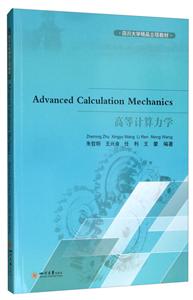扫一扫
关注中图网
官方微博
本类五星书更多>
-
>
宇宙、量子和人类心灵
-
>
(精)BBC地球故事系列-星际旅行
-
>
从一到无穷大
-
>
图说相对论(32开平装)
-
>
一本有趣又有料的化学书
-
>
刘薰宇的数学三书:原来数学可以这样学全3册
-
>
光学零件制造工艺学
高等计算力学 版权信息
- ISBN:9787569028300
- 条形码:9787569028300 ; 978-7-5690-2830-0
- 装帧:一般胶版纸
- 册数:暂无
- 重量:暂无
- 所属分类:>
高等计算力学 内容简介
本书着眼于固体结构或流体分析,介绍了有限元方法的基本原理及其在工程中的应用,指导学生使用Fortran、Matlab或C语言编译基本的有限元代码进行固体结构的应力和变形分析,对解决固体力学(如弹性力学、塑性力学、静力学、动力学等)、热传递(传导、对流、辐射)、流体力学、电磁学及流-固耦合等领域的问题具有指导作用。
高等计算力学 目录
Chapter 1 Discretization and element stiffness
1.1 Discretization of a domain by elements
1.2 Solution to the ease that the three-node displacements are known
1.3 Solutions to the case that the three-node loads are known
Chapter 2 Subroutine to calculate element stiffness matrix
2.1 Calculating triangle area
2.2 Calculating [B] strain matrix
2.3 Calculating [S] stress matrix
2.4 Calculating element stiffness matrix [K]
Chapter 3 Equivalent nodal forces
3.1 Concentrated load
3.2 Body force
3.3 Distributed force
3.4 Subroutine for body load
Chapter 4 Global stiffness matrix
4.1 Global stiffness matrix and its property
4.2 Global matrix establishment
4.3 The properties of global matrix
4.4 Subroutine of global stiffness matrix
Chapter 5 Boundary conditions and solution of equilibrium equations
5.1 Multiplying a large number
5.2 Decreasing the number of the linear equations
5.3 Changing the diagonal term to one
5.4 Subroutine of adjusting global matrix
5.5 Solver
Chapter 6 Subroutine of nodal stresses and main program
6.1 The calculation method of nodal average stresses
6.2 Subroutine of nodal stress
6.3 Main program
Chapter 7 Area coordinates and more node element
7.1 Area coordinates
7.2 Selection method of general displacement function
7.3 Six-node triangular element
7.4 Four-node rectangle element
Chapter 8 Axisymmetric stress analysis
8.1 Strain matrix
8.2 Stress matrix
8.3 Elements stiffness matrix
8.4 Equivalent nodal force
Chapter 9 Three-dimensional stress analysis
9.1 Tetrahedron element method
9.2 Volume coordinates
9.3 Tetrahedral element with 10 nodes and 20 nodes
9.4 Brick element
Chapter 10 Isoparametric element
10.1 Definition of isoparametric element
10.2 Mapping method
10.3 Quadrilateral element
10.4 Relationship between □(数理化公式)
10.5 Relationship between □(数理化公式)
10.6 Discussion
10.7 Some distorted elements
Chapter 11 Numerical integration
11.1 Newton-Cotes integration method
11.2 Gauss integration method
11.3 Gauss integration application in a standard element
11.4 Equivalent nodal force
Chapter 12 Dynamic finite element method
12.1 Formulation of time dependent problem
12.2 Inertial force
12.3 Damping force
12.4 Global equilibrium equation
12.5 Step by step integration method
Chapter 13 Automatic Mesh Generation in MATLAB
13.1 Introduction
13.2 The algorithm for mesh generation
13.3 Implementation
13.4 Special Distance Functions
13.5 Examples
13.6 Mesh Generation in 3-D
Chapter 14 Model Generation in ANSYS
14.1 Understanding Model Generation
14.2 Planning Your Approach
14.3 Choosing a Model Type (2-D, 3-D, etc.)
14.4 Choosing Between Linear and Higher Order Elements
14.5 Solid Modeling and Direct Generation
14.6 Generating the Mesh
14.7 Defining Material Properties
14.8 Applying Loads and Obtaining the Solution
14.9 Reviewing the Results
14.10 Structural Introductory Tutorial
1.1 Discretization of a domain by elements
1.2 Solution to the ease that the three-node displacements are known
1.3 Solutions to the case that the three-node loads are known
Chapter 2 Subroutine to calculate element stiffness matrix
2.1 Calculating triangle area
2.2 Calculating [B] strain matrix
2.3 Calculating [S] stress matrix
2.4 Calculating element stiffness matrix [K]
Chapter 3 Equivalent nodal forces
3.1 Concentrated load
3.2 Body force
3.3 Distributed force
3.4 Subroutine for body load
Chapter 4 Global stiffness matrix
4.1 Global stiffness matrix and its property
4.2 Global matrix establishment
4.3 The properties of global matrix
4.4 Subroutine of global stiffness matrix
Chapter 5 Boundary conditions and solution of equilibrium equations
5.1 Multiplying a large number
5.2 Decreasing the number of the linear equations
5.3 Changing the diagonal term to one
5.4 Subroutine of adjusting global matrix
5.5 Solver
Chapter 6 Subroutine of nodal stresses and main program
6.1 The calculation method of nodal average stresses
6.2 Subroutine of nodal stress
6.3 Main program
Chapter 7 Area coordinates and more node element
7.1 Area coordinates
7.2 Selection method of general displacement function
7.3 Six-node triangular element
7.4 Four-node rectangle element
Chapter 8 Axisymmetric stress analysis
8.1 Strain matrix
8.2 Stress matrix
8.3 Elements stiffness matrix
8.4 Equivalent nodal force
Chapter 9 Three-dimensional stress analysis
9.1 Tetrahedron element method
9.2 Volume coordinates
9.3 Tetrahedral element with 10 nodes and 20 nodes
9.4 Brick element
Chapter 10 Isoparametric element
10.1 Definition of isoparametric element
10.2 Mapping method
10.3 Quadrilateral element
10.4 Relationship between □(数理化公式)
10.5 Relationship between □(数理化公式)
10.6 Discussion
10.7 Some distorted elements
Chapter 11 Numerical integration
11.1 Newton-Cotes integration method
11.2 Gauss integration method
11.3 Gauss integration application in a standard element
11.4 Equivalent nodal force
Chapter 12 Dynamic finite element method
12.1 Formulation of time dependent problem
12.2 Inertial force
12.3 Damping force
12.4 Global equilibrium equation
12.5 Step by step integration method
Chapter 13 Automatic Mesh Generation in MATLAB
13.1 Introduction
13.2 The algorithm for mesh generation
13.3 Implementation
13.4 Special Distance Functions
13.5 Examples
13.6 Mesh Generation in 3-D
Chapter 14 Model Generation in ANSYS
14.1 Understanding Model Generation
14.2 Planning Your Approach
14.3 Choosing a Model Type (2-D, 3-D, etc.)
14.4 Choosing Between Linear and Higher Order Elements
14.5 Solid Modeling and Direct Generation
14.6 Generating the Mesh
14.7 Defining Material Properties
14.8 Applying Loads and Obtaining the Solution
14.9 Reviewing the Results
14.10 Structural Introductory Tutorial
展开全部
高等计算力学 作者简介
朱哲明:四川大学建筑与环境学院教授,博士生导师,连续入选Elsevier公布的中国高被引学者(在岩石力学与工程领域中国每年仅有2人入榜)。获得博士学位于著名的 McGill 大学,博士后及后来工作于著名的 Toronto 大学。先后在10余种国际著名刊物上,发表一百多篇论文。四川省学术和技术带头人,2014年获得四川省科技进步一等奖,先后主持和参与了国家自然科学基金项目,973国家重大科技研究项目,四川省科技项目,教育部创新团队等10余项纵向项目。
书友推荐
- >
伊索寓言-世界文学名著典藏-全译本
伊索寓言-世界文学名著典藏-全译本
¥6.1¥19.0 - >
中国人在乌苏里边疆区:历史与人类学概述
中国人在乌苏里边疆区:历史与人类学概述
¥24.0¥48.0 - >
诗经-先民的歌唱
诗经-先民的歌唱
¥15.1¥39.8 - >
唐代进士录
唐代进士录
¥19.1¥39.8 - >
史学评论
史学评论
¥13.9¥42.0 - >
我从未如此眷恋人间
我从未如此眷恋人间
¥16.4¥49.8 - >
大红狗在马戏团-大红狗克里弗-助人
大红狗在马戏团-大红狗克里弗-助人
¥3.3¥10.0 - >
上帝之肋:男人的真实旅程
上帝之肋:男人的真实旅程
¥19.3¥35.0
本类畅销
-
2022图书×抽奖盲袋
¥9.9¥25 -
2023读书月阅读盲盒——天黑,闭眼,刀谁?
¥42.3¥158 -
2022读者节纪念徽章-三星会员专属
¥45¥45.6 -
2023读书月阅读盲盒——我什么场面没见过?
¥42.3¥158 -
2023读书月阅读盲盒——去码头整点什么薯条?
¥42.3¥158
















